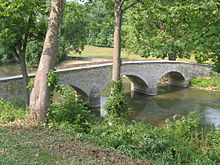Burnside's Bridge
| Burnside's Bridge | |
|---|---|
 |
|
| Coordinates | 39°27′02″N 77°43′55″W / 39.45056°N 77.73194°WCoordinates: 39°27′02″N 77°43′55″W / 39.45056°N 77.73194°W |
| Carries | Pedestrians |
| Crosses | Antietam Creek |
| Locale | Sharpsburg, Maryland |
| Characteristics | |
| Design | Arch |
| Material | Stone |
| History | |
| Opened | 1836 |
Burnside's Bridge is a landmark on the Civil War Antietam National Battlefield near Sharpsburg, northwestern Maryland.
Seeking to improve connections between roads in Washington County, fourteen bridges were commissioned to be constructed. It is one of five bridges designed by master bridge builder John Weaver, its construction was completed 1836. It was constructed by local Dunker farmers. The three-arched, 12-foot (3.7 m)-wide, 125-foot (38 m)-long bridge provided a passageway over Antietam Creek for farmers to take their produce and livestock to market in Sharpsburg. The bridge's three arches are constructed of locally sourced coursed limestone, masonry walls contain the roadbed and has wooden parapets. The original cost of construction was $3200 (now between $73,000 and $84,000.)
The bridge has two other names, one is "Rohrbach's Bridge", after a local farmer Henry Rohrbach who lived nearby. The second name, "Lower Bridge" is in reference to the Upper Bridge and Middle Bridge located further upstream that also allowed movement of freight, animals, and people across the creek.
Crossing over Antietam Creek, the bridge played a key role in the September 1862 Battle of Antietam during the American Civil War when around 500 Confederate soldiers from Georgia under General Robert Toombs and Henry Benning, for several hours held off repeated attempts by elements of the Union Army's IX Army Corps, whose leader was Major General Ambrose E. Burnside, to take the bridge.
The first attempt was by Col. George Crook's Ohio brigade, partially supported by Edward Harland's brigade of Rodman's Division, but the Ohioans got lost, and emerged too far upstream. The 11th Connecticut Infantry found the bridge, and engaged the Georgians under Brig. Gen. Robert Toombs. After taking heavy casualties, the 11th Connecticut withdrew in all haste.
...
Wikipedia
